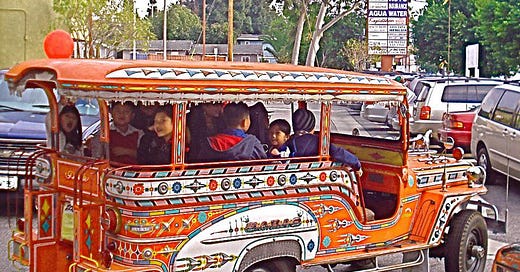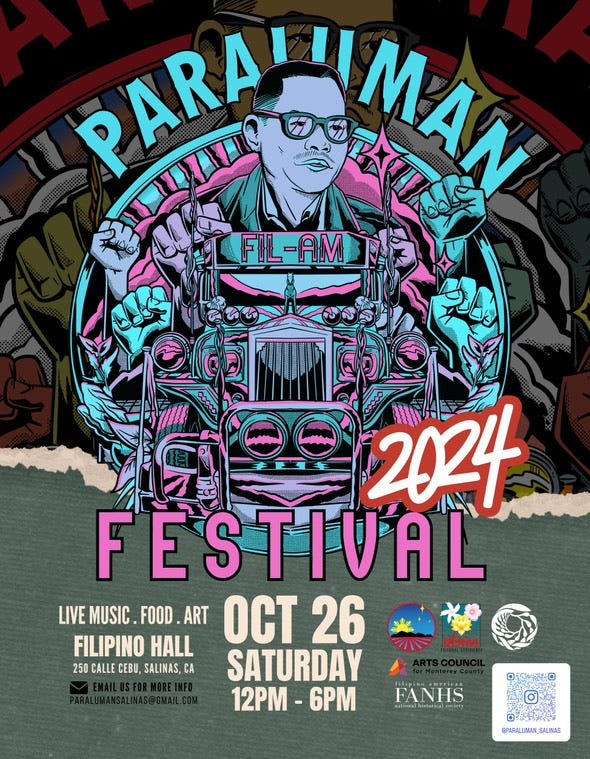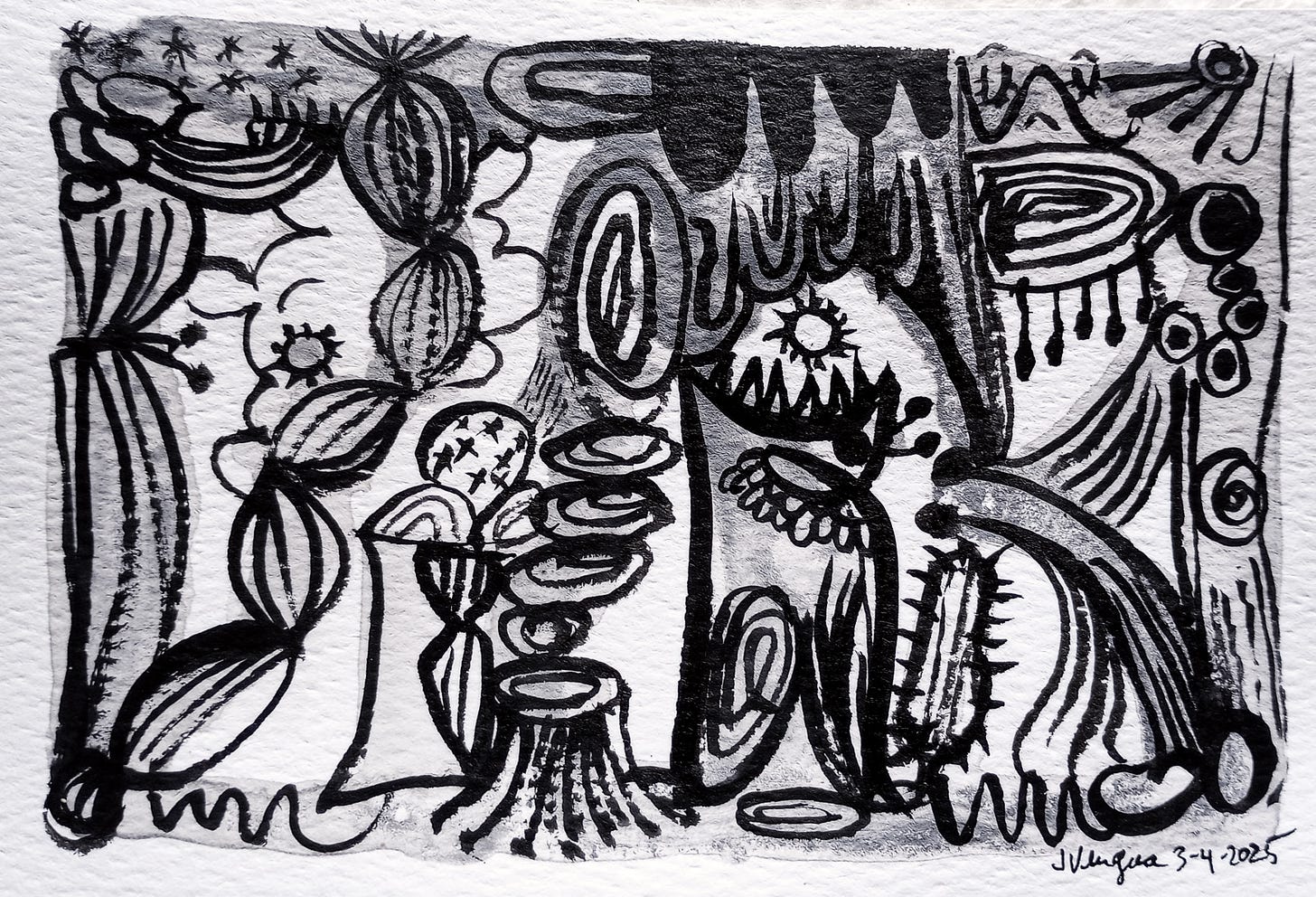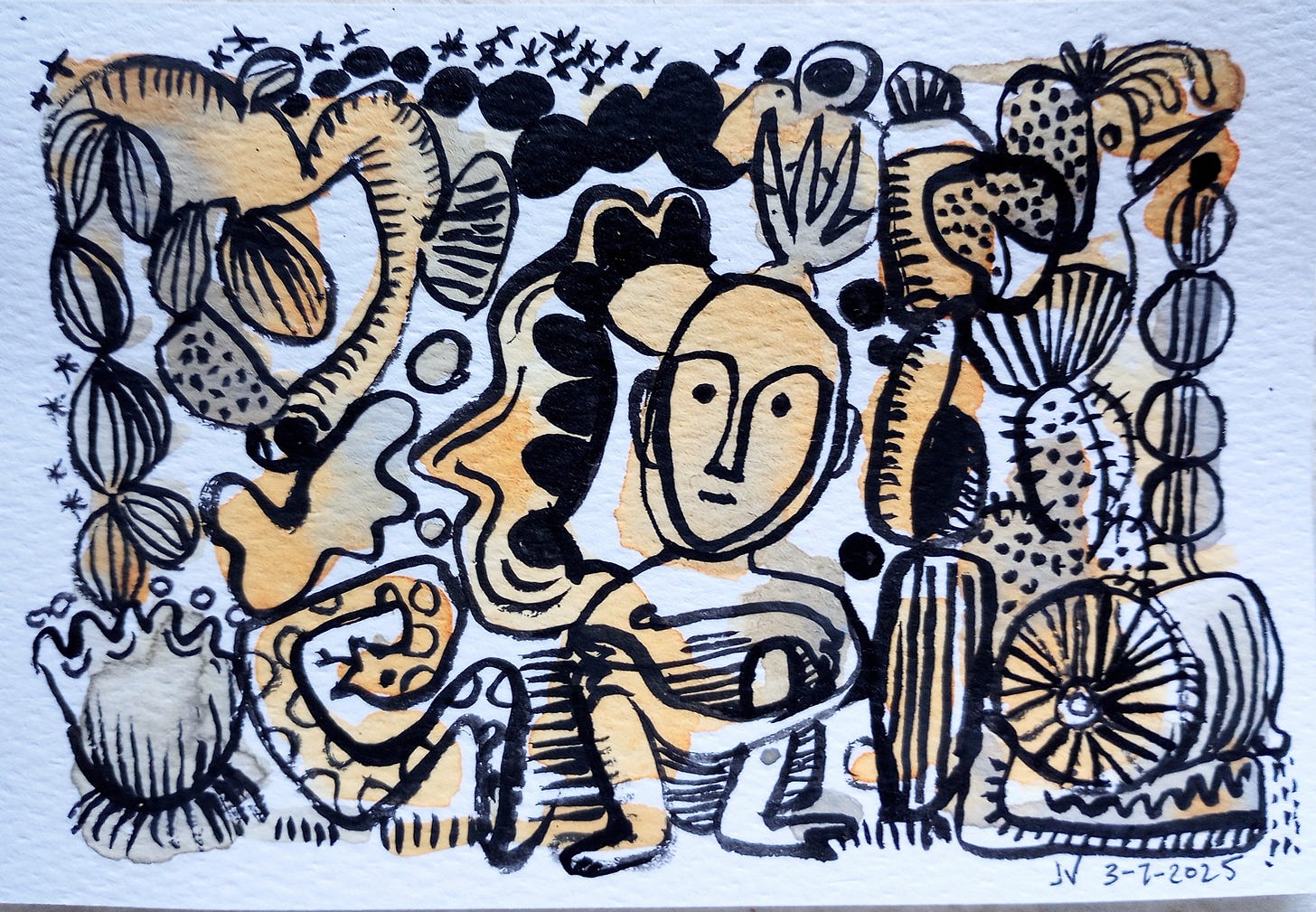Art, Memory, and Jeepneys
#184: Art, Memory & Jeepneys; Katrin de Guia, Amalia Mesa-Bains, Wilfredo Lam, Sean Sullivan, Philippine Komiks, Ukrainian Art, "Not for Sale" Queer Art, Strictly Jeepney Music, & Sama' Abdulhadi
Art, Memory, and Jeepneys
I started this issue by writing about art, memory, and iconography — and somehow ended up with jeepneys. Bear with me:
Sometimes artists create art objects and rituals in order to tap into memories that need to surface. The mind is by nature restless, looping continually through its memories and related emotions, even when doing so doesn’t seem helpful. While creativity can be enjoyable and provide a way to focus my mind, it can also have a healing effect. At the very least—it can help place memories in proper perspective. Personally, I need this outlet as a way to work through thoughts and feelings.
In some cultures, people construct altars that appear at certain times of the year. Time and seasonal repetition are often important in stimulating memories and emotions. My own art was part of an ofrenda last October, which combined Filipino and Mexican art in a gallery show at Urban Arts Collaborative. Visually, the items used in such altars are iconographic;1 they focus on certain persons or experiences and remind me of things I want to keep in my life or let go of. Perhaps writing can work similarly. There is even something a bit ritualistic about the repetition of blogging or newsletter writing. It calls you to be creative, to have a little courage, and start writing.
Speaking of public altars like ofrendas, I realize that, while my experiences have very personal meaning, perhaps they are not mine alone; some aspects of my experience are common and relatable within a community setting. Posters and other graphics echo the iconography of altars in the way they center iconic figures among symbols. In the image below by stay bacon, labor activist Larry Itliong is centered above a “Fil-Am” sign (for Filipino Americans) and a Philippine jeepney, which itself is surrounded by raised fists—a symbol of resistance against oppression.
Jeepneys are vehicles that were left behind in the Philippines by American troops after WWII, and later utilized by Filipinos for public transportation. They are always brightly painted and become symbolic art objects in themselves. Many also include religious altars!
Unfortunately the vehicles have also contributed to air pollution in the Philippines and the government is trying to phase them out and replace them with less colorful transport vehicles (many from China) that are more sustainable for the environment. Independent jeepney drivers have recently gone on strike, complaining that the new regulations will cause them to lose their income and independence.2
The following video on the history of jeepneys in the Philippines is from Digital Nomads Explore:
Mail Art
We live in a culture that tends to place monetary value on anything that takes time, including art. Mail art is usually free and tends to work outside the art markets.
During the pandemic, my lines started getting small, finicky, detailed, but still abstract.
Last week, I switched out of that mode and my lines loosened up. What prompted it? Mail art, for one, and also aging. Although my hands are still fairly steady, arthritis and carpal tunnel from all my editing work sometimes make it painful to draw fine lines and details. So I switched to a looser style and am enjoying it. The smaller size and repetitive nature of producing mail art also helps with “loosening up.” I no longer wonder—about halfway through the drawing—how long I’ll be able endure the stiffness and pain in my fingers.
The fact that the art is not for sale also takes a lot of pressure off art making and helps me focus on the creative process and just having fun.3 I don’t keep the art (except in digital form). I send it out into the world. Whoever receives it can do what they want with it—keep it, frame it, gift it, or even recycle parts of it into more art that continues its journey from one person to another.
The “bulul” is an ancestor spirit among the Ifugao people of northern Luzon, Philippines. The bulul guards the crops and assures a good harvest. The crops usually consist of rice or tubers. I tend to put a lot of succulents and cacti in my drawings. They are fun to draw.
RABBIT HOLE
German artist and psychologist Katrin de Guia on how meeting a jeepney driver changed her life:
Amalia Mesa-Bains is well known for her installations and ofrendas, altars drawing from the Dia de los Muertos traditions. In the video below she speaks of the “archaeology of memory.” What’s interesting to me here is her differentiation between “history” and the more personal realm of “memory” in the practice of her “interventions, especially in the laboratories and libraries.”
[Memory as intervention] isn’t about loitering in the past or being nostalgic. It is the trajectory of survival. It’s how we sustain ourselves. It’s a strategy of defiance, a strategy of being in the world when you are not recognized.—Amalia Mesa-Bains
Cuban artist Wilfredo Lam:
Wilfredo Lam: a Collection of 53 Works:
Conversation with artist Sean Sullivan (Hiroyuki Hamada). I’m especially interested in his discussion of the improvisational process in making art:
Sean: I think improvisation begins before you even sit down to work. It’s an exercise in faith or the practice of faith maybe? I don’t mean that in a religious sense per se, but faith in ability, in intention and in good outcomes. A trust that you can make something from nothing and even if there are ‘mistakes’ or setbacks, by adjusting expectations you can land in a more unexpected, inspired place. There is no right, there is no perfect and starting from that point - everything, every mark makes sense and has a place.
History of Philippine Komiks by Ernesto Lawagan (Ernee’s Corner).
Ukrainians transforming sorrows into art (from Jefferson Hernandez Segovia, Daily Trojan). Art is one way to move forward despite overwhelming challenges.
“There is an image outside of Ukraine that Ukrainians are heroes, and they are not broken. We disagree on that because we think that almost each of us now, after 1,106 days of this full-scale invasion,” Starovoyt said. “We all are broken.”
“‘Not for Sale’ redefines queer art gallery as a space for expression, not transaction.” The article discusses the 2025 exhibition, “Not For Sale: A Radical Statement on Art, Value and Integrity.” (Jake Wittich, Jan. 15, 2025, Windy City Times).
SOUNDINGS
“Strictly Jeepney Music” a short percussive mix by Green Mango:
Sama’ Abdulhadi on what it’s like to be a Palestinean DJ traveling around the world (2 years ago):
My gratitude goes to everyone who reads Eulipion Outpost regularly, and especially to those who have subscribed or donated on my Ko-fi page to support my efforts.
My ongoing appreciation goes to the Mysterious M. for his excellent editing skills.
Website and blog: Jeanvengua1.wordpress.com
A Crooked Mile (a blog)
CommonwealthCafe (Filipino American & AAPI history and print culture)
Eulipion Outpost is a reader-supported publication. To receive new posts and support my work, consider becoming a free or paid subscriber.
See my link to the work of artist Mary Heilman in the previous issue of EO.
The government is telling jeepney drivers that they must now join cooperatives or work under corporate management.
However, there is an aspect of mail art that can be considered “pressure”: if you receive art, you may feel pressure to produce art to send to other mail artists. The more mail art you receive, the more pressure you feel!











Great interviews! Love the story of Kidlat Tahimik.